Passionfruit sponge cake – a classic Australian dessert that is actually relatively simple but so divine. The sponge is only lightly sweetened. It’s filled with cream and tangy passionfruit making even a big slice a heavenly light treat.
- Easier than you might expect
- Such a classic and a showstopper
- Fluffy feather-light sponge cake
- Tangy passionfruit
- Clouds of whipped cream
I’m truly excited to share this recipe with you. I’ve been wanting to create a perfect light and fluffy sponge cake recipe for a long time. Similar to a genoise sponge but without any butter, the eggs in this batter are whipped until thick, pale and pillowy. The resulting cake is incredibly light and perfect for topping with the toppings of your choice.
This one inspired my strawberry sponge cake and you’ll love this lemon meringue cake too.
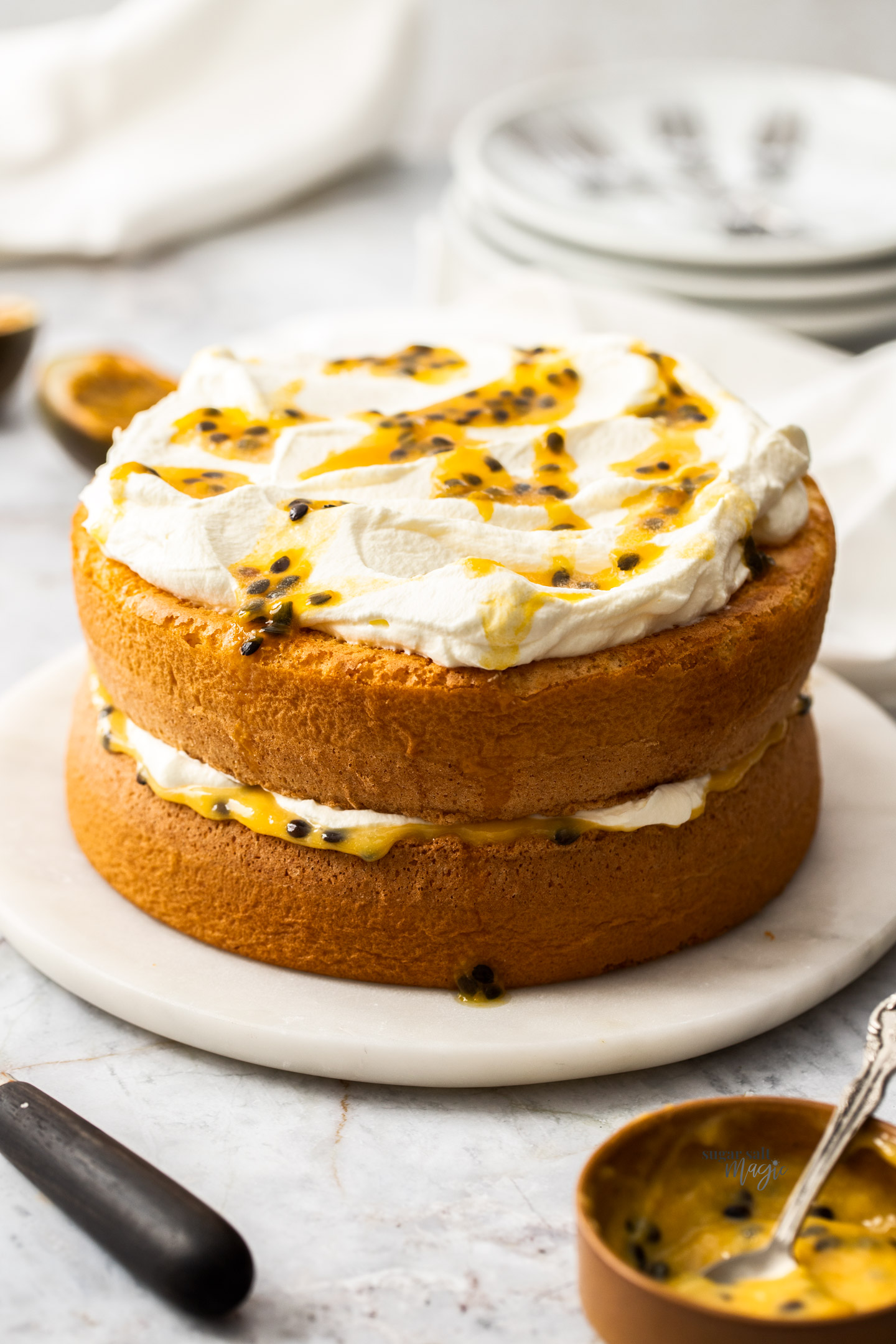
FEATURED COMMENT
Fantastic cake! My Dad loves it and says it is the perfect type of sponge cake.
Fiona
Never Miss a Recipe!
Get the latest recipes straight to your inbox!
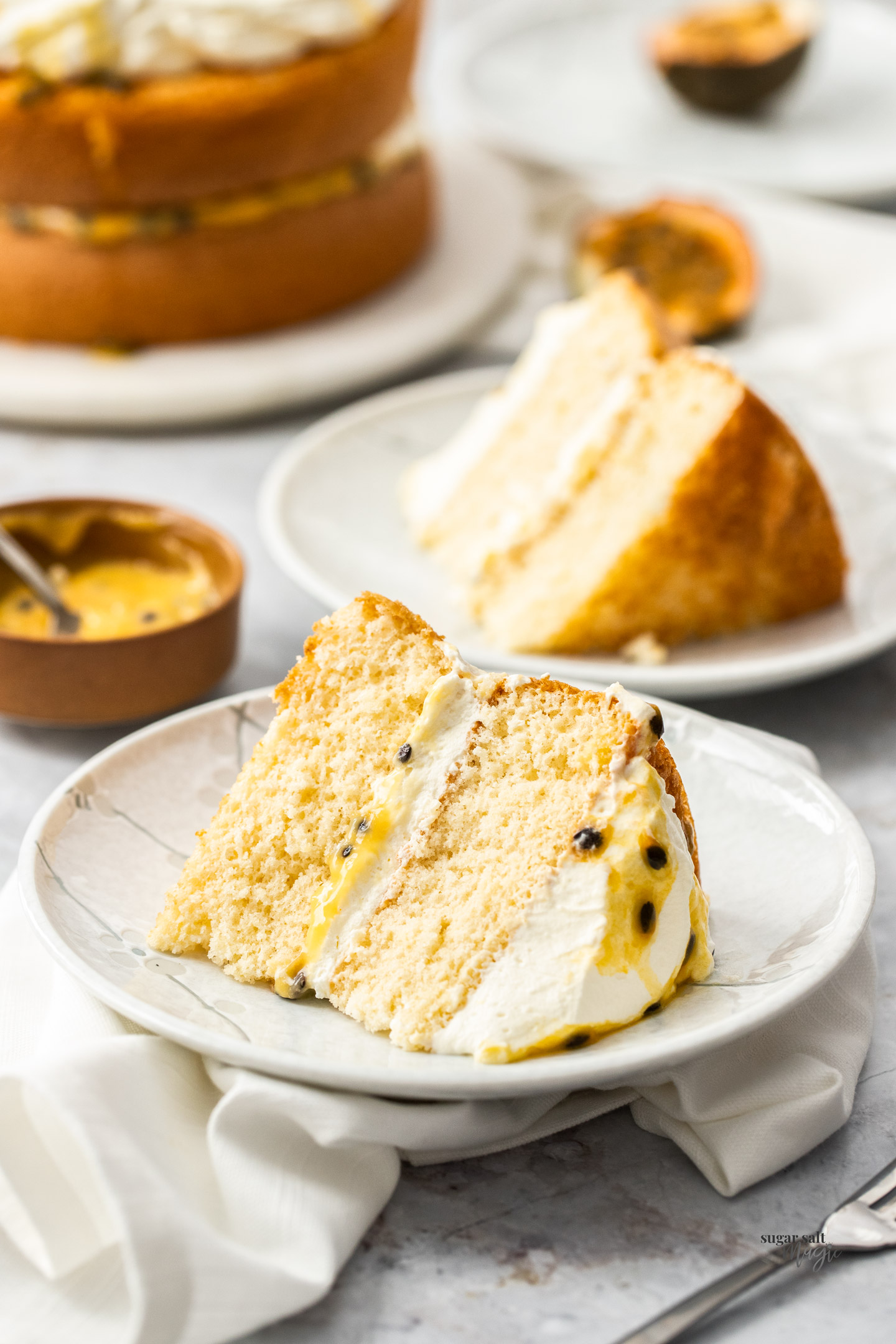
What is passionfruit sponge?
This is an iconic Aussie dessert. The classic passionfruit sponge is similar to a genoise sponge and is filled with cream and passionfruit pulp, then has a layer of passionfruit icing on top.
For mine, I chose to fill it with sweet and tangy passionfruit curd and whipped cream, then kept the topping simple with whipped cream and passionfruit pulp. I have included a recipe for the classic icing if you prefer that.
A classic sponge can be decorated / flavoured in so many ways so make sure to check out my variations section.
Keep in mind, a sponge cake is typically not a moist cake. It has a drier texture and is often drizzled with a syrup of some kind or loaded up with cream for moisture.
Ingredients you’ll need
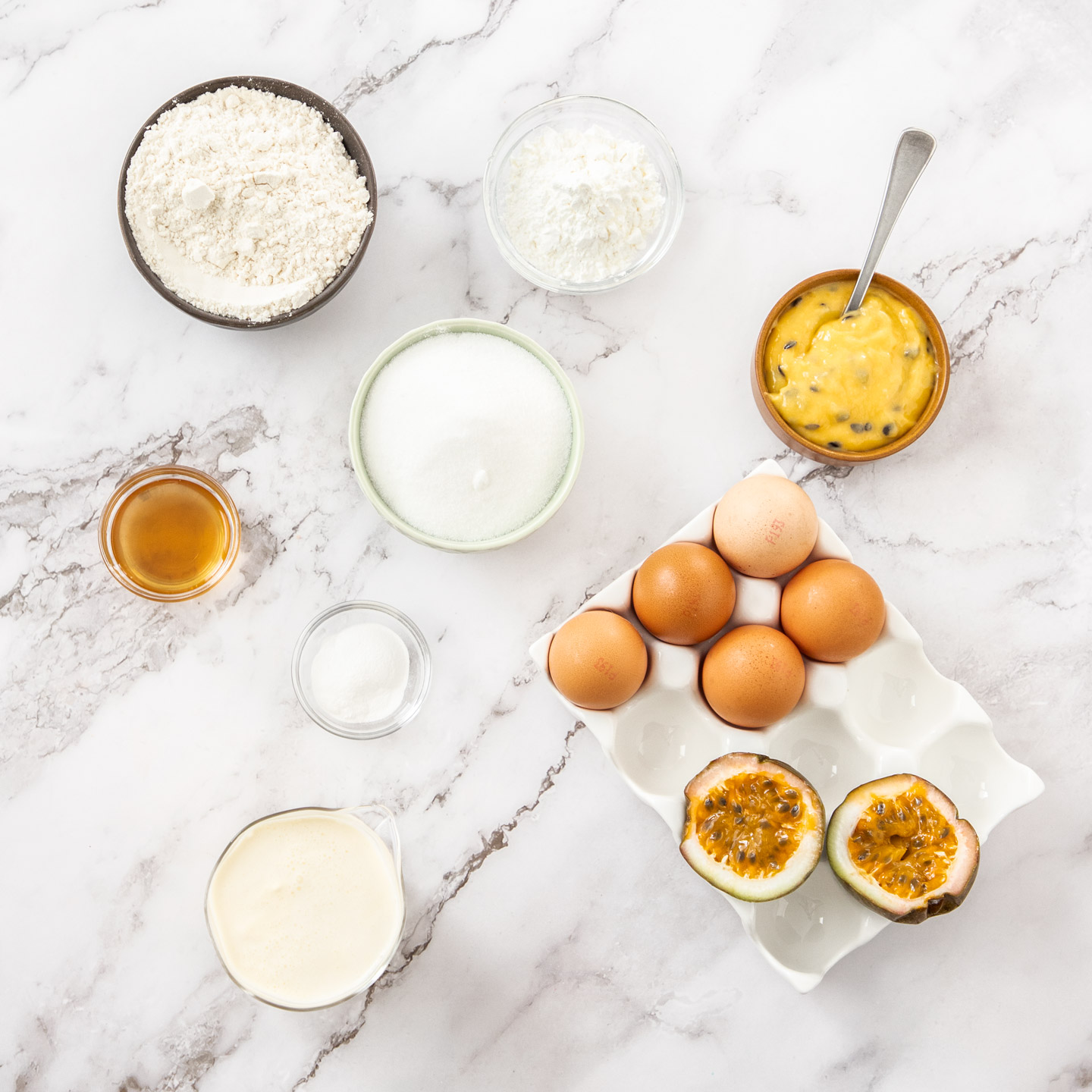
Detailed quantities and instructions in the recipe card below.
- Water: As with many classic sponges, water is the only liquid required.
- Vanilla: Always use pure vanilla extract, not vanilla essence. The latter is a synthetic flavouring.
- Flour: You’ll need two types of flour. The first is plain flour (aka all purpose flour) and the second is cornflour (aka cornstarch). Cornflour helps with a softer texture. You can use cake flour in place of both flours, but not one or the other.
- Baking powder: Make sure to use baking powder and not baking soda. They work differently.
- Eggs: I use large free-range eggs. Make sure they’re at room temperature.
- Sugar: I use caster sugar (superfine sugar) for this but white granulated sugar works fine.
- Cream: Use fluid whipping cream or a thickened cream or heavy cream with at least 35% milk fat.
- Passionfruit Curd: I make my own passionfruit curd from scratch and I’ve linked to the recipe. You can make it 2-3 days ahead. I’ve also included a recipe for the classic passionfruit icing, if you don’t want to make curd.
- Passionfruit pulp: Fresh or from a jar, just a little is used over the top of the cake.
If you want to take this cake to the next level, you can brush a little passionfruit syrup over the cake layers before topping.
The testing process
I mentioned I’ve been wanting to create a gorgeous, light and fluffy sponge cake for a long time and I’m so happy she’s finally here.
I started by testing a number of times using variations of traditional sponge recipes. Unfortunately they never quite had the results I wanted – tall cakes with straight, golden sides, that don’t sink and the inside must be light and fluffy with just the right amount of sweetness.
When making my fairy bread lamingtons, I wondered if I could adjust my lamington sponge to be more of a classic sponge recipe and BINGO! While many sponge recipes call for bicarb soda (baking soda), I found it made the outside too dark for my liking. My lamington sponge uses baking powder instead and it was the perfect leavener. While most genoise type sponges include a very small amount of butter, I wanted to keep things simple so left it out. I swapped the milk for water, the liquid of choice for a classic sponge, and reduced the amount of flour. I use some cornflour to keep the cake softer.
- You can swap both the plain flour and the cornflour for cake flour (but not one or the other).
- You’ll beat the eggs until ribbon stage (more below) and this will take around 8 minutes with an electric beater.
- Folding using a metal spoon is very important – it cuts cleanly through the batter without destroying all the air you’ve beaten into the eggs.
- Sifting the flour twice is also important as it aerates and lightens the flour (many recipes do it three times and you are more than welcome to do this, though I don’t find it makes a huge difference in this recipe).
- The folding motion is also very important – this again stops the air you’ve created from being destroyed.
This recipe took me some time to perfect but it was worth every moment and I’m so proud to share this recipe with you.
How to make passionfruit sponge cake (step-by-step)
While it has technical aspects, with the right tips, making a sponge cake is not as difficult as you might think. The filling and topping are easy too.
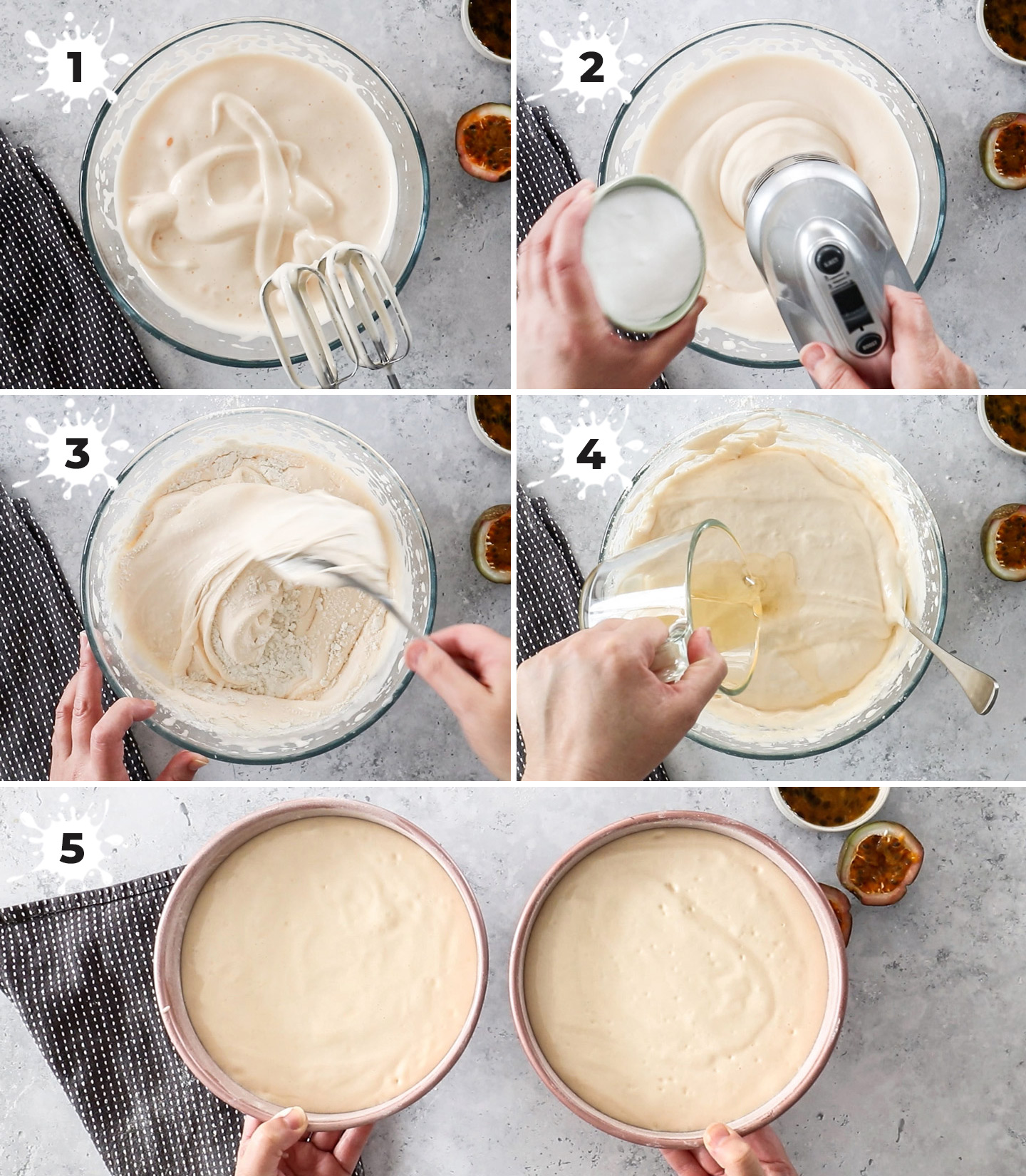
Detailed quantities and instructions in the recipe card below.
Make the sponge
- Combine water and vanilla and set aside.
- Sift the flour, cornflour and baking powder together, then whisk together and set aside.
- Beat the eggs to ribbon stage in a large bowl.
- Sift in the dry ingredients, half at a time, folding carefully with a metal spoon after each until 90% combined.
- Add the wet ingredients and fold them in until fully incorporated, again with the metal spoon.
- Tip the batter into two sandwich tins (8 inch cake pans) evenly and bake for around 20 minutes.
- Let them cool for 5 minutes before inverting onto wire racks to cool completely.
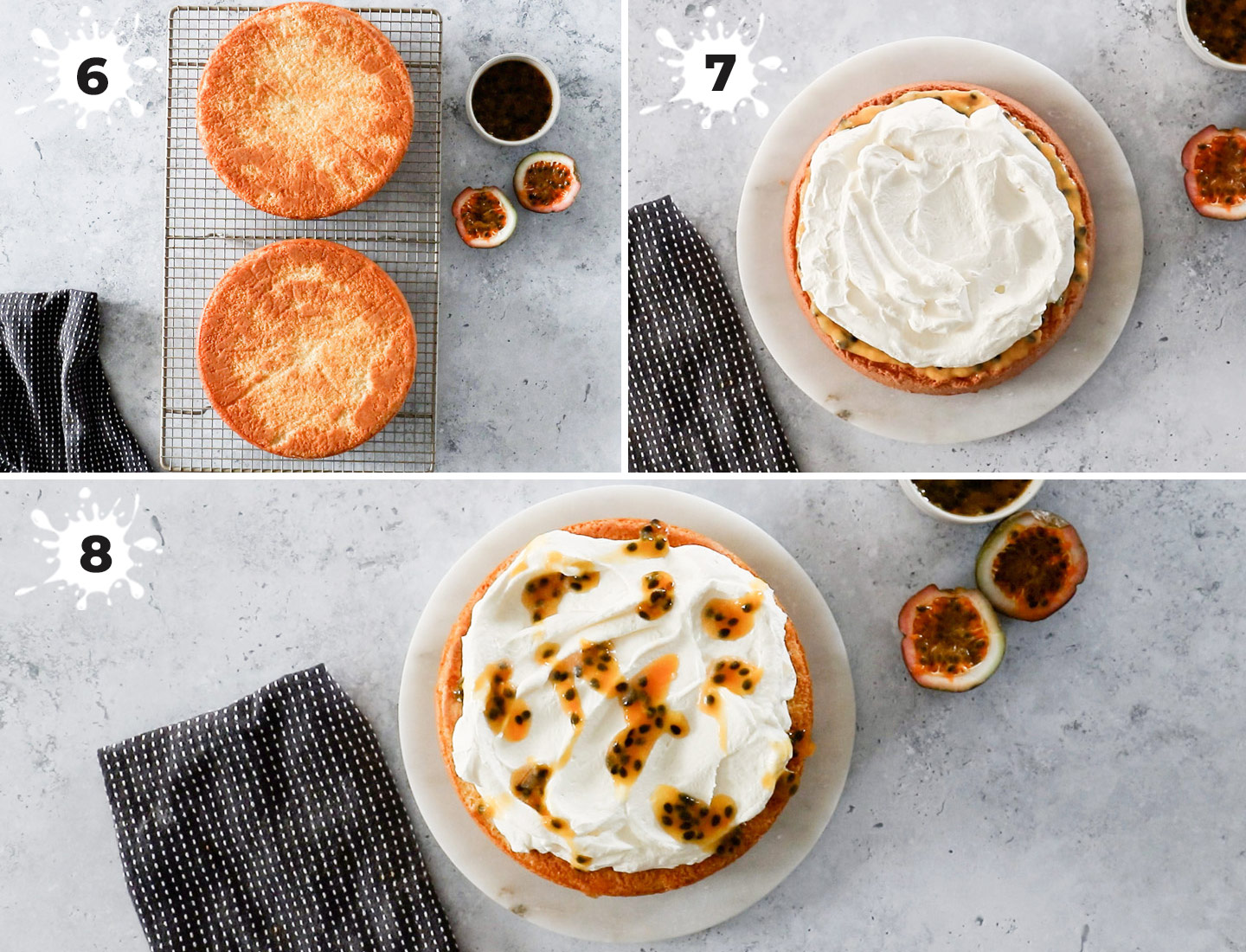
Assemble the cake
- Whip the cream.
- Spread a layer of passionfruit curd onto one of the cakes, then top with half the cream.
- Put the other cake on top and top that with the remaining cream.
- Drizzle over fresh passionfruit pulp and serve.
Tips and tricks
- Ribbon stage: Beating eggs to ribbon stage means to beat them with an electric beater or a stand mixer with a whisk attachment until they are thick, fluffy and pale. When you lift the whisk out, you can use the dripping batter to draw an 8 on the surface of the batter without it sinking away.
- Using a metal spoon is very important to this recipe as it allows you to cut cleanly through the batter without breaking up too much of the air that you’ve beaten in.
- Folding: Make sure to use a folding action – again this serves to help retain as much of the air in the batter as possible (where stirring would knock it out). To fold batter you want to dig from the bottom edge of the bowl, then bring the spoon towards you, lifting and folding the batter over itself. Repeat this until your ingredients are just incorporated. Don’t overmix.
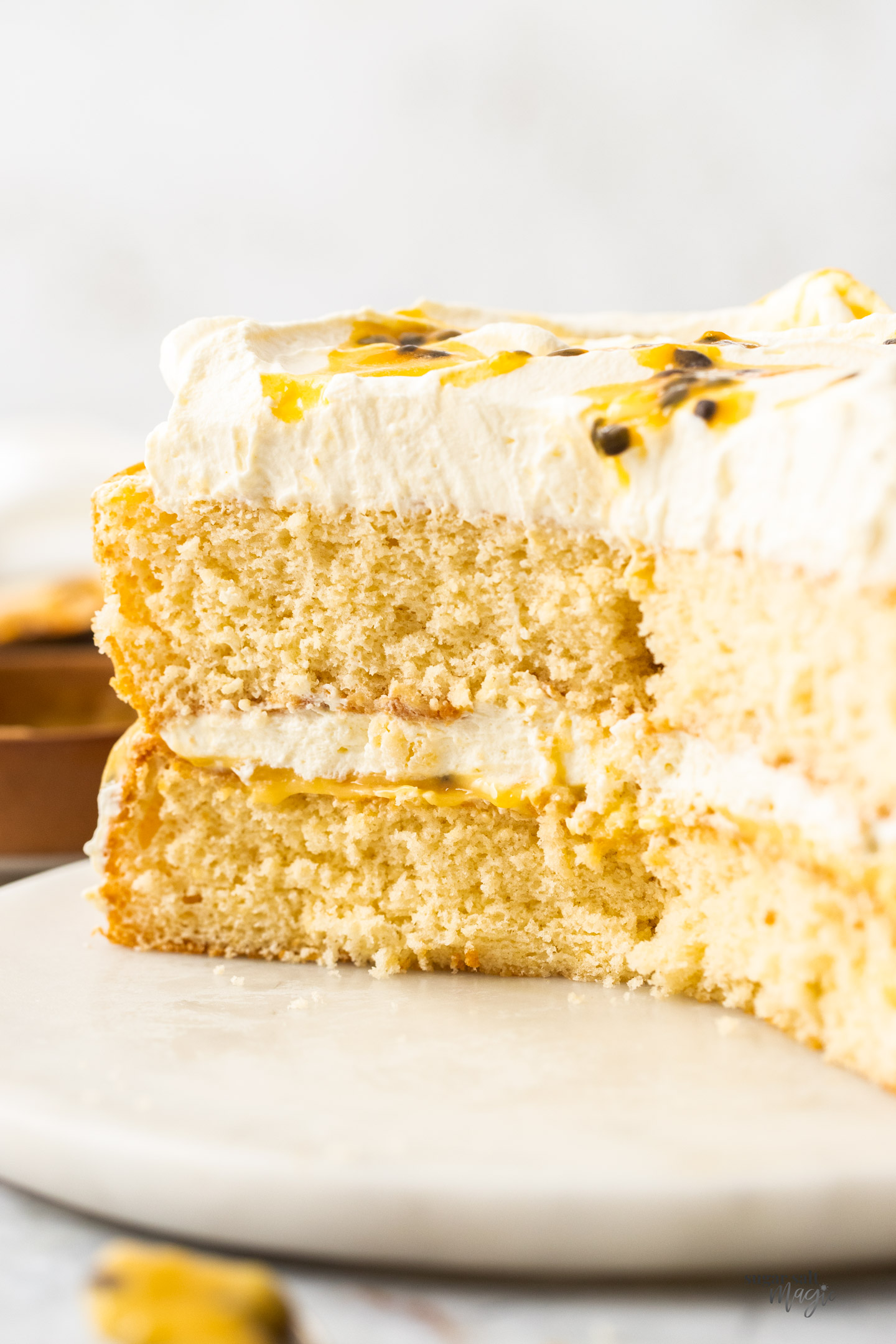
Variations
- Passionfruit icing: For the more classic passionfruit sponge cake recipe, leave out the curd and instead mix 2 cups of icing sugar with 2 tablespoons of melted butter and 3 tablespoons of passionfruit pulp. Layer the cake with half the amount of cream and a drizzle of passionfruit pulp in the middle then spread the icing on the top layer of the cake.
- No icing / curd: You can simplify this recipe even more by beating 2 tablespoons of icing sugar (powdered sugar) into the cream as you whip it. Use that to fill and top the cake with a drizzle of passionfruit pulp on each layer. I recommend adding the sugar to the cream as this cake isn’t super sweet and the passionfruit is very tangy so the sugar in the cream helps to balance it.
- Other curds: You can use any of my curd recipes and make this recipe into the flavour of your choice. Try lemon curd, blackberry curd, lime curd, mango curd or blood orange curd.
- Victoria sponge: A classic Victoria sponge has a filling of jam and cream and a dusting of icing sugar on top. Add the cream first to the bottom layer, then top with jam (use double the amount as I use curd in this recipe). The classic flavour is strawberry but you ca use any flavoured jam you like.
Yield and storage
This is a tall 8 inch cake and serves 10-12.
This passionfruit sponge cake can be stored in the fridge in an airtight container for 2-3 days.
The unfilled, un-topped sponge cake layers can be frozen for up to 3 months. Wrap them twice in plastic wrap and freeze them in an airtight container.
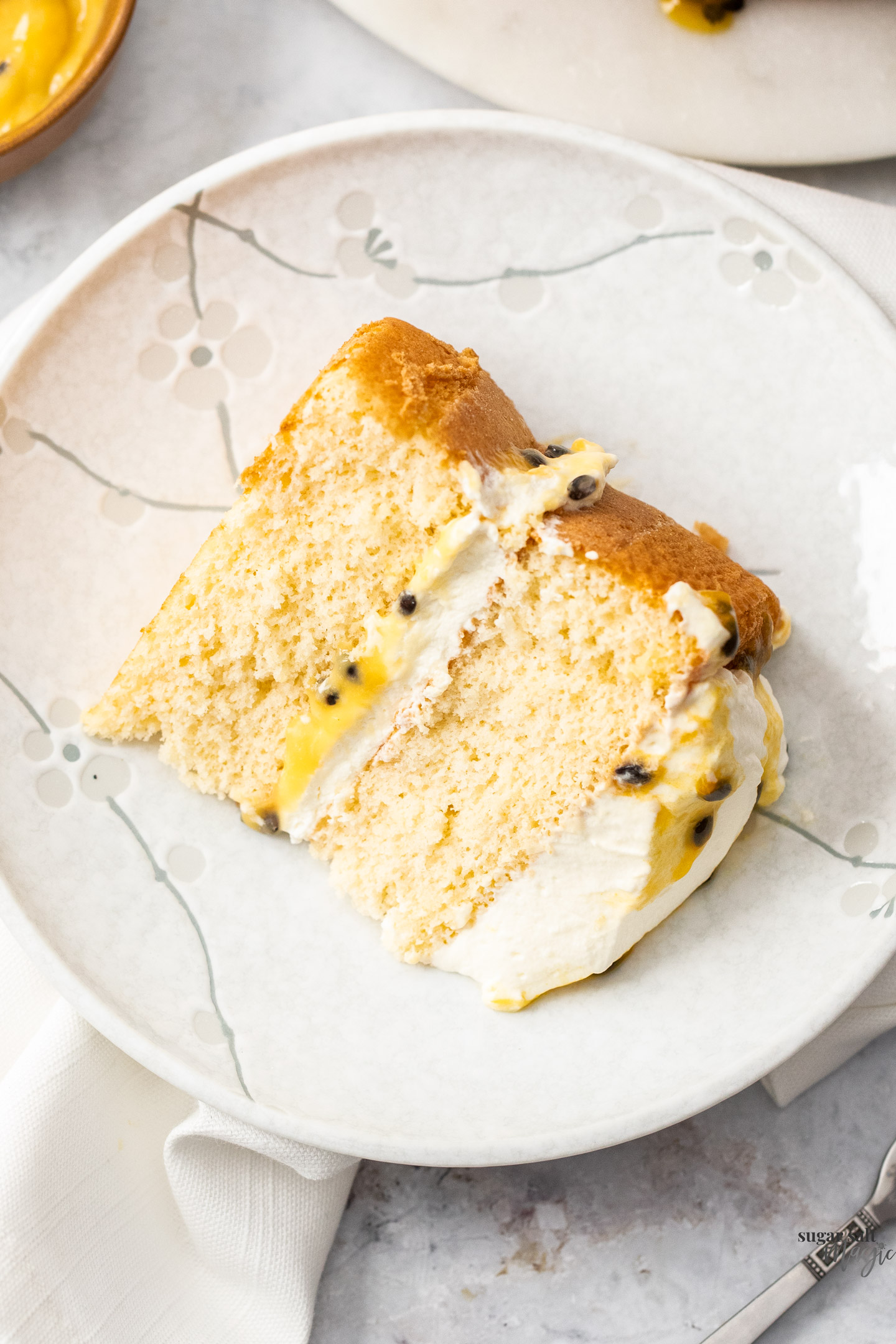
Did you try this passionfruit sponge cake recipe?
Leaving a rating and comment below the recipe is so helpful!
Hungry for more? Subscribe to the newsletter for free recipes straight to your inbox. Also, follow along on Facebook, Pinterest and Instagram.
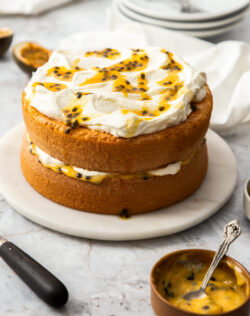
Ingredients
- ¼ cup water, room temperature
- 2 teaspoons vanilla
- 1 ¼ cups plain flour (all purpose flour) (165g / 5.8oz)
- ¼ cup cornflour (cornstarch) (35g / 1.2oz)
- 1 ½ teaspoons baking powder
- 5 whole large eggs, room temperature
- 200 g caster sugar (superfine sugar or granulated sugar) (1 cup / 7oz)
- 1 ½ cups fluid whipping cream
- ½ cup passionfruit curd (or see notes 10 for other options)
- 2 tablespoons passionfruit pulp
For best results, always weigh ingredients where a weight is provided
Equipment
- Fine mesh sieve
- Small jug
- Medium and large mixing bowls
- Metal spoon
Instructions
- If you're making your own passionfruit curd, do this first (and up to 3 days in advance).
- Preheat oven to 180C (160C fan) / 350F.
- Grease two 8 inch round cake tins (or sandwich tins) with softened butter. Line the base with baking paper then roll flour around the inside to coat the sides of the tin before tapping out the excess.
- In a small jug, combine the water and vanilla. Set aside.
- Into a medium bowl, sift together the plain flour, cornflour and baking powder then use a whisk to whisk them together well.
- Crack the eggs into a large mixing bowl. Beat using an electric beater until they get to ribbon stage – about 8 minutes. Test ribbon stage by lifting the beaters out and letting it run off the beaters in a figure 8 – if the 8 doesn’t sink away, it’s ready. They will be very thick, pale and fluffy at this point.
- While beating on low, gradually add the sugar. Once all the sugar is added, beat for another 1 minute.
- Sift half the flour mixture directly over the egg mixture (this second sift is important) then use a metal spoon to very gently fold them together. Once it’s about 90% incorporated, repeat with the remaining half of the flour mixture.
- Fold it through with a metal spoon again until 90% combined.
- Add the water mixture and carefully fold it through with the metal spoon until fully incorporated.
- Tip evenly into the two baking tins and bake for 20-22 minutes until a toothpick comes out clean.
- Let the sponges cool in the tins for 5 mins before turning out onto wire racks to cool completely.
- Place one layer onto a cake plate, then spread over ½ cup of the passionfruit curd.
- In a medium bowl, whip the cream to firm peaks, then spread half over the top of the passionfruit curd.
- Place the top layer on and gently spread the remaining cream over the top, then drizzle the passionfruit pulp over the top.
- Please take a moment to leave a comment & rating. It's appreciated and so helpful.
Notes
- Keep in mind, a sponge cake is typically not a moist cake. It has a drier texture and is often drizzled with a syrup of some kind or loaded up with cream for moisture.
- For best results, you should always weigh ingredients like flour and sugar. Kitchen scales are relatively cheap but if you can’t weigh the ingredients, use the spoon and level method (don’t scoop).
- All ovens vary – always test for doneness 3-5 minutes before the recipe suggests.
- Flours: You can swap both the plain flour and the cornflour (cornstarch) for cake flour (but not one or the other).
- Ribbon stage: Beating eggs to ribbon stage means to beat them with an electric beater or a stand mixer with a whisk attachment until they are thick, fluffy and pale. When you lift the whisk out, you can use the dripping batter to draw an 8 on the surface of the batter without it sinking away.
- Metal spoon: Folding using a metal spoon is very important – it cuts cleanly through the batter without destroying all the air you’ve beaten into the eggs.
- Sifting: Sifting the flour twice is also important as it aerates and lightens the flour (many recipes do it three times and you are more than welcome to do this, though I don’t find it makes a huge difference in this recipe).
- Folding: The folding motion is also very important – this again stops the air you’ve created from being destroyed.
- Classic icing: For the more classic passionfruit sponge cake recipe, leave out the curd and instead mix 2 cups of icing sugar with 2 tablespoons of melted butter and 3 tablespoons of passionfruit pulp. Layer the cake with half the amount of cream and a drizzle of passionfruit pulp in the middle then spread the icing on the top layer of the cake.
- Flavours: If you don’t want to use passionfruit, use any flavoured curd or even jam you prefer.
This post may contain affiliate links that earn me a small commission for my referral, at no extra cost to you. Thank you for supporting Sugar Salt Magic.

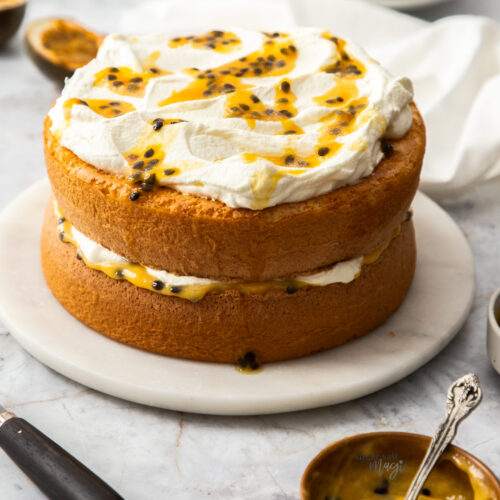
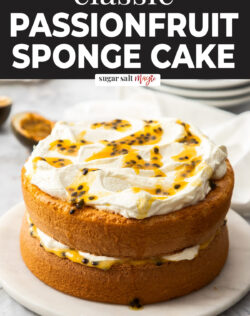

6 Comments on “Passionfruit Sponge Cake”
Not sure if the baking powder/plain flour ratio is right. Folded very carefully but still very dense cake. Would either use self-raising flour or way more baking powder next time.
Sorry Brit but if it’s turned out dense, you’ve made a mistake somewhere along the way. There’s no issue with the ratios – I make this cake regularly and you can see the light texture in the photos. You don’t want to add more baking powder or you won’t be making a sponge cake – a true sponge traditionally has no baking powder at all. Also, there is no more baking powder in self raising flour than in the combination I’ve used in this recipe. I use plain flour since not everyone has access to self-raising. First, make sure you’re getting the eggs to figure 8 stage. Make sure you very gently fold the flour in with a metal spoon – this way you won’t upset all the aeration you’ve added. The batter should be very thick, fluffy and voluminous once it’s ready.
Hi. Could I add passionfruit pulp to the cake batter? I would like the sponge to have a passionfruit flavour.
Untested, I couldn’t say. Sponge is quite a technical ratio of ingredients so I’m not sure if passionfruit pulp would just mix right through. You could, add a passionfruit syrup the cake, letting it soak into the cakes after they’re baked.
Fantastic cake! My Dad loves it and says it is the perfect type of sponge cake.
This is so great to hear. Thanks for making my recipe, Fiona.